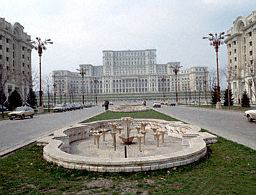Vacation Packages
Bucharest vacation packages
bucharest Hotels
- Bucharest luxury hotels 5*:
- Bucharest first class hotels 4*:
- Bucharest budget hotels 3*:
- Selection of gut rated hotels in Bucharest:
The capital of Romania, Bucharest once considered itself the Paris of the East, because of its Western-style architecture and stimulating social life. The luxurious style of life enjoyed by the upper class vanished after 1947 when the Communists came to power, but the city remained a major centre of culture, industry, and trade.
Bucharest is located in southern Romania on the Dîmbovita River, a tributary of the Danube River, at a meeting place of early trade routes across the Walachian Plain. Its climate is continental, with hot summers and cold winters, when icy winds often blow from the north. Several parks and lakes north of the city provide recreational areas where residents can escape from summer heat.

Bucharest vacation packages

The original old town was situated on the small hills along the banks of the Dîmbovita. This area now contains the Patriarchate Church, the more modern Parliament Building, and the adjacent Union Square (Piata Unirii). To the north stretch the major boulevards--Victory Street (Calea Victoriei) and its extension, Kisselef Highway (Soseaua Kisselef)--laid out in the mid-19th century. After World War I the city expanded rapidly, and wider streets were completed--notably the north-south Balcescu and Magheru boulevards and the east-west Gheorghe Gheorghiu-Dej and Republic ii boulevards. Lined with public buildings, stores, hotels, and apartments, they form the centre of the modern city.
Many of Bucharest's buildings are reminiscent of Paris and other Western capitals; among them are the university, the former royal palace (now the Palace of the Republic), the Atheneum (concert hall), the post office, and the Arch of Triumph. Several old Orthodox churches, however, mark Bucharest as an Eastern European city. Bucharest, which has maintained its famous old luxury hotels, has a major modern hotel in the city's centre. Nearby is the massive former headquarters of the Communist party. A huge building in the ornate style favoured during the Stalin period was built at the end of Kisselef Highway to house the editorial and printing offices of all the country's newspapers and magazines.
People
Most of the people are Romanian, though there are also small numbers of Hungarians, Gypsies, and others. The majority of the people belong to the Romanian Orthodox church, and many still attend services in Bucharest's 18th-century churches. Theatre, ballet, and opera are popular. Bucharest is the seat of the state philharmonic orchestra. There are museums of art, history, and traditional culture.
Children between the ages of 6 and 16 must attend state schools. Bucharest has a university, founded in 1864; a polytechnic institute, founded in 1819; and other institutions of higher education.

Bucharest - History
BUCHAREST, Romania
Brief History
Bucharest began as a fort on the Dîmbovi ta River, but its location on the trade routes across the Walachian Plain between the Danube River and the Carpathian Mountains stimulated further growth. In the 17th century it became the capital of the state of Walachia. After the foundation of the state of Romania in 1859, it became the capital of the new country.
Between that time and World War I, the city grew in size, but the most rapid period of expansion took place following the war. It was during this period that the city took on its present appearance.
Romania sided with Germany during World War II, and Bucharest was damaged by Allied air raids. After the war the centre of the city was rebuilt, and new industrial and residential districts were laid out. In 1947, when the Communists came to power, Bucharest became the capital of the new Socialist republic. A disastrous earthquake on March 4, 1977, destroyed many of the poorly constructed buildings in the centre of the city and killed about 1,500 people. A major effort was made to reconstruct the damaged areas. After the fall of Romania's Communist government in February 1990, Bucharest became the capital of the new republic. Population (1989 estimate), 2,194,583.
Tags: Bucharest travel guide, vacation rentals, hotels, package holidays, points of interest, car rental, city breaks, weather